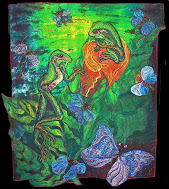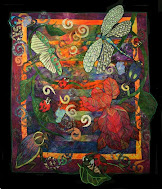Wednesday, January 13, 2010
Hoop-Dee-Doo
Most people who do even minimal free motion embroidery are familiar with the distortion issue. It's only natural. You run that much thread through that much fabric and your fabric ruffles like a child's party dress. There are a bunch of tricks that help, but nothing actually cures it. It's the same situation as having a cold. We can make it better but it doesn't go away. Stitch choices, and stabilizers help, and we'll talk about those another day. But one of the best helps is a hoop.
A hoop keeps your fabric from bunching up, going down the needle hole and all kinds of other bad behavior. In holding the fabric tightly, it makes your machine stitch better. And a hoop is something you can hold on to and manipulate easier than just your fabric. Good hoops last for ever and are worthy studio tools.
I have several hoops in my studio for different purposes. And several hoops I wouldn't use for anything but ring toss. The biggest issue with hooping comes down to two factors: How thick is your project? and How densely did you intend to stitch.
The Hoop That Came With Your Machine
A lot of times people will come in with the hoop that came with their embroidery machine. It's not a bad hoop. It usually has good grip and the sizes are usually sensible. They don't accommodate anything thick though. They're made for one layer of fabric and a stabilizer, maybe.
The Hoop That Came With Your Machine
A lot of times people will come in with the hoop that came with their embroidery machine. It's not a bad hoop. It usually has good grip and the sizes are usually sensible. They don't accommodate anything thick though. They're made for one layer of fabric and a stabilizer, maybe.
The Hardwood Hoop
I use a German hard wood hoop that has a screw. I'm not being nationalistic here. That's simply what they're called. I assume they do come from Germany, but I don't really know.They're made of a dense thin hardwood. These hoops are narrow and fit under the machine foot. They also have a screw with a slot on one side that lets you tighten the surface, which insures a better stitch.I keep an 8", and a 10" square one. Any hoop over 10" will not give consistent enough support and you'll get skipped stitches.
This is the hoop of choice for free motion embroidery on a piece of lightly stabilized cotton. I use them when I'm embroidering a sold image on a single layer of fabric. You can put a hoop on a project with more than one layer, but it get's harder as they layers add up.
Did you fuse on several sheers? Have a layer of cut away or embroider on the top as well? At a certain point your wooden hoop is hard to use.That's the time to bring out
Did you fuse on several sheers? Have a layer of cut away or embroider on the top as well? At a certain point your wooden hoop is hard to use.That's the time to bring out
The Halo
This is Sharon Schamber's creation. It's a metal weighted hoop dipped in a rubber substance that grips. Originally I believe she made them for long arm stitching and they're great for that. Instead of clamping them on, the weight holds them in place and you can slide it along as you stitch.
When I saw these, I bought three of them on sight. Two for the studio and one to travel. They are an astonishing help for free motion. I often have a piece where I've stabilized it with a layer of fused on felt or several layers of fused sheers onto window shade interfacing.I bring them into class because I consider them an essential studio tool. You can also stack two of them together for more stability.
They do not work for any embroidery that isn't solidly backed by stabilizer, so you'll want a wooden hoop for that.
Ring Toss Hoops:
These are the hoops that are cruel hoaxes. They have no use in machine embroidery. I take them away from students in class because I'm afraid they'll hurt themselves on them.
These are the hoops that are cruel hoaxes. They have no use in machine embroidery. I take them away from students in class because I'm afraid they'll hurt themselves on them.
Spring Hoops
I never use a spring hoop, because they tend to do just that.Sprong! Right while you're sewing! I really take a down on anything that springs up out of my project while I'm stitching.I consider them dangerous and I take them away from students in class and let them borrow one of mine if they need to.
Cheap wooden hoops
You find these at craft stores. They're thick. The wood splinters and cracks. I believe they're made for hand-embroiderers but I wouldn't use it for that. They're not only inexpensive, but they're cheap too in their making. Who needs splinters?
Wrapping it up
Wrapping it up
Good hoops make your work easier, flatter, and much more fun. You can find Sharon's halo at her web site at http://www.sharonschamber.com/shopping%20cart/new%20products/newproducts.htm
You can find good hardwood hoops at most sewing machine stores. I bring both kinds to students in class when I'm teaching. A good hoop helps make for a good sewing day.
Subscribe to:
Post Comments (Atom)
Ellen Anne Eddy's Flowers on Youtube.com
Labels
lunatic fringe
(22)
design
(18)
life as an artist
(18)
lifestyle
(18)
story telling
(11)
art quilting
(8)
fiber art
(8)
art quilters
(7)
books
(6)
color
(6)
free motion
(6)
gardening
(5)
Thread Magic Garden
(4)
embroidery
(4)
quilters
(4)
quilting
(4)
C and T Publishing
(3)
craft
(3)
flowers
(3)
Christmas
(2)
What problem?
(2)
archetypes
(2)
beads
(2)
bias
(2)
bobbin work
(2)
classes
(2)
filling the grid
(2)
sewing
(2)
threads
(2)
zigzag stitch
(2)
Wizard of Oz
(1)
choir
(1)
knitting
(1)
machine stitching
(1)
movies
(1)
seasons
(1)
youtube
(1)
Like us on Facebook

Quiltposium, Fall2011

Ellen's New Article, Dance of Design
Essential Embroidery Stitches: Free Hand and Machine Embroidery Designs and Techniques.
The Butterfly Effect

Blog Archive
-
▼
2010
(63)
-
▼
January
(16)
- The Case for Kits-I have to follow the instructions?
- Thread Savy-Why dye! The Case for Hand-dyed Thread
- Thread Savy-Why dye! The Case for Hand-dyed Thread
- Thread Savy- Thick Metallic Threads
- Thread Savy- Thick Metallic Threads
- Musings: Art Outside the Box. Your Authentic Voice
- Thread Savy-Metallic Threads
- Thread Savy-Metallic Threads
- Thread Savy- Mono-filament Threads
- Thread Savy- Mono-filament Threads
- Thread Savy-Basic Embroidery Thread
- Thread Savy-Basic Embroidery Thread
- Hoop-Dee-Doo
- Hoop-Dee-Doo
- The Needle Knows
- The Needle Knows
-
▼
January
(16)
My Blog List
-
1 day ago
-
1 week ago
-
3 weeks ago
-
4 weeks ago
-
4 weeks ago
-
1 year ago
-
4 years ago
-
5 years ago
-
5 years ago
-
6 years ago
-
6 years ago
-
8 years ago
-
8 years ago
-
8 years ago
-
9 years ago
-
9 years ago
-
9 years ago
-
9 years ago
-
10 years ago
-
10 years ago
-
11 years ago
-
11 years ago
-
11 years ago
-
11 years ago
-
11 years ago
-
12 years ago
-
12 years ago
-
12 years ago
-
12 years ago
-
12 years ago
-
13 years ago
-
13 years ago
-
13 years ago
-
13 years ago
-
13 years ago
-
-
-

Facebook Badge
Labels
archetypes
(2)
art quilters
(7)
art quilting
(8)
beads
(2)
bias
(2)
bobbin work
(2)
books
(6)
C and T Publishing
(3)
choir
(1)
Christmas
(2)
classes
(2)
color
(6)
craft
(3)
design
(18)
embroidery
(4)
fiber art
(8)
filling the grid
(2)
flowers
(3)
free motion
(6)
gardening
(5)
knitting
(1)
life as an artist
(18)
lifestyle
(18)
lunatic fringe
(22)
machine stitching
(1)
movies
(1)
quilters
(4)
quilting
(4)
seasons
(1)
sewing
(2)
story telling
(11)
Thread Magic Garden
(4)
threads
(2)
What problem?
(2)
Wizard of Oz
(1)
youtube
(1)
zigzag stitch
(2)











7 comments:
I totally agree with you about the Halo - a brilliant invention.
Please could you post a picture of your hardwood hoop ?
I am enjoying your blog so much! Thank you for being so generous with your knowledge.
My hunt is now on for a square hoop-------I didn't even know they were available!
:o)
This is wonderful information. Thank you so much.
yurtdışı kargo
resimli magnet
instagram takipçi satın al
yurtdışı kargo
sms onay
dijital kartvizit
dijital kartvizit
https://nobetci-eczane.org/
DG3C
Almanya yurtdışı kargo
Belçika yurtdışı kargo
Bulgaristan yurtdışı kargo
Çekya yurtdışı kargo
Danimarka yurtdışı kargo
U0QHQ
Libya yurtdışı kargo
Liberya yurtdışı kargo
Lesotho yurtdışı kargo
Laos yurtdışı kargo
Kuzey Marina Adaları yurtdışı kargo
5ER0QE
Kuzey İrlanda yurtdışı kargo
Kuveyt yurtdışı kargo
Kosta Rika yurtdışı kargo
Kosraey yurtdışı kargo
Güney Kore yurtdışı kargo
BY3U
Post a Comment